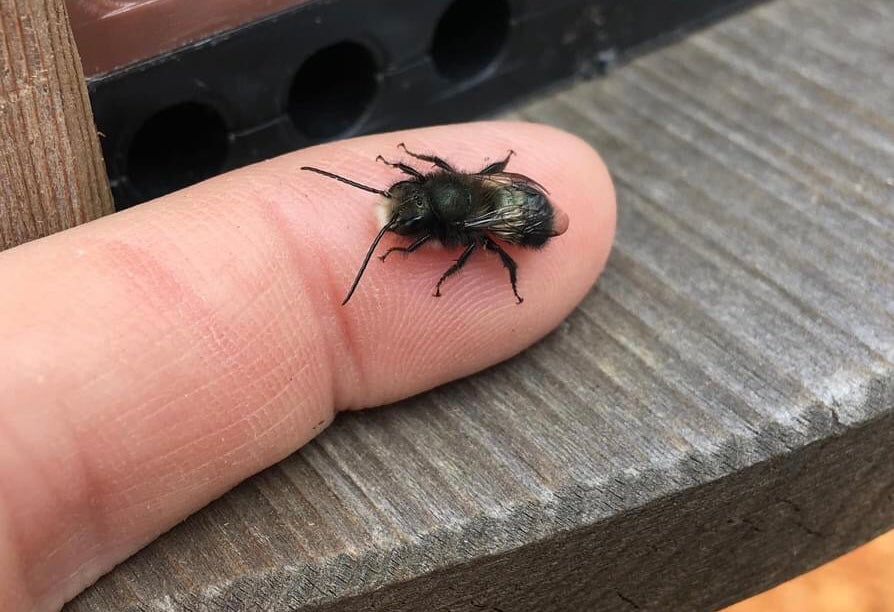Welcome to the wonderful world of mason bees! At West Coast Plants, we raise Blue Orchard mason bees and sell cleaned bee cocoons early each spring.
MASON BEE LIFECYCLE
Mason bees are beneficial, native, solitary spring pollinators, especially helpful in the home fruit and vegetable garden. They don't make honey, but in relatively cool spring weather, you'll find them pollinating your garden and fruit trees, while it's still too cold for many other pollinators, including honey bees.
Mason bees are very docile and are unlikely to sting. In fact, the males don't even have stingers and the females are all solitary and fertile so they'd much rather reproduce than engage. They go about their business, caring little about your presence; you can stand immediately in front of a mason bee house and watch the bees come and go as though you weren't even there.
In ten years of raising and handling mason bees, we've never been stung. This is one reason mason bees are such a great activity for the whole family!
Mason bees nest in narrow cavities, up to about 6 inches long. We can imitate their natural nesting cavities, like holes in reeds, by making bee houses with nesting holes or tubes, thereby providing more habitat for native bees and giving us an opportunity to interact with them. One 6-inch cavity can be filled with multiple eggs, separated by mud walls. We've seen up to 13 cocoons in just one 6-inch-long nesting tube.
Male mason bees are smaller than females and emerge first, chewing their way out of their cocoons and then through the mud walls between them and the tube entrance. Once out, they wait nearby for several days to weeks for the females to follow. The female cocoons, which are also visibly larger, are usually further down the nesting tubes, ensuring they exit last.
Why would the males emerge first? A female who emerges and has no male to mate with is not going to help the species reproduce. If the males are already there, waiting, it ensures each female can mate successfully. And, by having the females closer to the back of the nesting tubes, they are more protected from woodpecker predation and parasitic insects.
After mating with the males, the females begin their life's purpose of collecting pollen and mud and laying eggs for the next year's population. Males, done their deed, soon die off.
Females, who are all fertile, are the ones who do the work pollenating your garden. Apparently, they are 120 times more effective at pollinating than honey bees or bumble bees and you only need 250-300 females to effectively pollinate an entire acre of fruit trees. These, are busy bees!
They collect mud to make a partitioning wall within the nesting cavity/tube. Then they collect pollen and nectar, making a pollen-nectar ball within the cell. Once the ball is large enough, the female lays an egg on top and seals up the cell with another mud wall. The female repeats this process, filling up the cavity. She lives roughly 4-6 weeks and, by early summer, the weather has warmed and the female mason bees die-off.
All that is left of the population, until the following spring, is the eggs inside the nesting cavities. That means adult mason bee do not overwinter, only their young do.
The eggs hatch into larvae, which eat the pollen balls as their food source. Eventually, they spin a waterproof cocoon and wait until spring to chew their way out of the cocoons and then out of the mud walls and begin the lifecycle again.
CLEANING POLLEN MITES OFF MASON BEE COCOONS
To support the wild mason bee population, many people will create houses for them full of nesting tubes or long cavities. The houses can be opened mid-winter and the cocoons collected and cleaned. Why is it so important to clean the cocoons? Pollen mites! Pollen mites eat the pollen balls meant for the bee larvae, starving them. They can negatively impact many native bees in this way, so ensuring the your bees start life without a coating of pollen mites, is helpful for all.
The collection and cleaning process is relatively straight forward. The tubes or cavities are opened, the cocoons collected, then washed, dried and stored somewhere cool, like in a container in the fridge. This mimics winter and ensures they do not emerge early if there's a warm spell.
We'll be adding a detailed post with instructions on cleaning mason bee cocoons.
RELEASING MASON BEES IN SPRING
In the spring we, put our bee cocoons outside once the weather has warmed and the trees are starting to blossom. We wait for three consecutive days with temperatures at or above 14ºC (57ºF), and watch for when approximately 25% of our fruit trees are in blossom. Then we choose a dry, warm day with little wind.
Here at West Coast Plants, on central Vancouver Island, we release our mason bees in early and mid April. We like to release them in at least two batches, two weeks apart. The bee cocoons are removed from the fridge and released at (or in) their wood houses. The young bees then chew their way out of their cocoons when they are ready. You can actually hear them chewing!
COLLECTING MASON BEE HOUSES IN SUMMER
Even if you don't plan to clean your houses and cocoons, it's still important to protect them from predators like woodpeckers, pests like the Houdini fly, and the elements, such as rain and fungal spores.
The ideal place to store your mason bee house is somewhere dry, protected and cool. We store ours in an unheated garage. If you do leave it outdoors, consider putting the house inside a fine mesh bag to keep pests away, like parasitic wasps.
In the following video, you'll see how and why we collect our mason bee houses once the females are done laying eggs. You'll also get to see pollen balls and mason bee larvae.
Best of luck on your adventures with mason bees and don't hesitate to get in touch!
- Mariah Wilde, West Coast Plants

